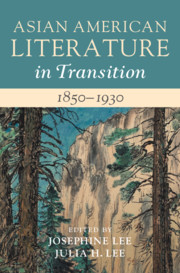Book contents
- Asian American Literature in Transition, 1850–1930
- Asian American Literature in Transition
- Asian American Literature in Transition, 1850–1930
- Copyright page
- Contents
- Illustrations
- Notes on Contributors
- Series Preface
- Introduction: Asian American Literature in Transition, 1850–1930
- Part I Empire and Resistance
- Part II Bodies at Work and Play
- Part III Crossings
- Chapter 12 Affect and Form in the Writings of the Eaton Sisters
- Chapter 13 Osato-san’sHands
- Chapter 14 Revolutionary Formalisms
- Chapter 15 Slave to Love
- Chapter 16 Anna May Wong’s Greetings to the World
- Bibliography
- Index
Chapter 16 - Anna May Wong’s Greetings to the World
from Part III - Crossings
Published online by Cambridge University Press: 27 May 2021
- Asian American Literature in Transition, 1850–1930
- Asian American Literature in Transition
- Asian American Literature in Transition, 1850–1930
- Copyright page
- Contents
- Illustrations
- Notes on Contributors
- Series Preface
- Introduction: Asian American Literature in Transition, 1850–1930
- Part I Empire and Resistance
- Part II Bodies at Work and Play
- Part III Crossings
- Chapter 12 Affect and Form in the Writings of the Eaton Sisters
- Chapter 13 Osato-san’sHands
- Chapter 14 Revolutionary Formalisms
- Chapter 15 Slave to Love
- Chapter 16 Anna May Wong’s Greetings to the World
- Bibliography
- Index
Summary
This chapter studies Anna May Wong’s active construction of her international star/celebrity status through “greetings” to the world. My goal is to understand how she mobilized such “greetings” to retool the film and media apparatus into an empowering relation-building vehicle. I argue that her relation-building stems from multi-registered audience address in her “greetings,” which elicit divergent responses depending on the viewers’ lingua-cultural knowledge and sociopolitical consciousness. I dwell on two categories of “greetings”: scriptural “greetings” as illustrated in her signature in gifted photos, in Piccadilly (dir. E. A. Dupont 1929) and in a lithographic visual map showing the European cities she performed in from 1933 to 1934; and performative “greetings” as seen in her reiterative dialect performances in Hollywood on Parade A-3 (June 5, 1932) and the “China Mary” episode of an ABC Western TV show, The Life and Legend of Wyatt Earp (aired on March 15, 1960). Methodologically, I depart from simply tracing Wong’s empirical reception to develop strategies of taking cues from Wong’s “greetings” so as to reactivate and parse out her ability to speak to audiences of disparate stances across history. This alternative lineage of performer-spectator dynamic deconstructs the race-gender ideology underpinning mainstream film and media, and harbingers a more self-reflexive interstitial identitarian position.
Keywords
- Type
- Chapter
- Information
- Asian American Literature in Transition, 1850–1930 , pp. 281 - 301Publisher: Cambridge University PressPrint publication year: 2021

